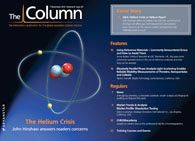Dragon's blood
"Dragon's Blood"(DB) has become increasingly popular in Europe and the USA this year. Marketed as an anti-ageing compound within cosmetics, DB is a deep red resin secreted from the fruit of the dragon tree species, Daemonorops draco. Scientists in China 2 believe they have identified two novel biomarkers that could be used in the QC of DB.
‘Dragon’s Blood’ (DB) has become increasingly popular in Europe and the USA this year. Marketed as an anti‑ageing compound within cosmetics, DB is a deep red resin secreted from the fruit of the dragon tree species, Daemonorops draco. Historically used in Chinese medicine to improve blood circulation for the treatment of traumatic injuries, it also has reported antimicrobial, antiviral, antitumor and cytotoxic activity.1 However, as with the claims of many other cosmetics and herbal preparations, the actual concentrations of active ingredients are often below the effective level for action.
At the present time, there is only one biomarker that is quantified for quality control (QC) purposes within Dragon’s Blood, dracorhodin, and as there is an inherent variability in biomarker concentration this is an unreliable quality control method. Scientists in China 2 believe they have identified two novel biomarkers that could be used in the QC of DB. Using ultra-high performance liquid chromatography (UHPLC) coupled with a photodiode array (PAD) and electron ionization mass spectrometry (ESI‑MS), the scientists characterized six flavenoids known to be contained in the DB resin. The scientists identified two novel potential biomarkers, (2S)-5-methoxyflavan-7-ol and (2S)‑5‑methoxy-6-methylfavan-7-ol. It is hoped that with further investigation, the QC analysis method used will improve the quality of DB products.
1. J. Shi et al, J Sep Sci. 32(23–24), 4040–7 (2009).
2. T. Yi et al, Chemistry Central Journal, 6(116)(2012).
This story originally appeared in The Column. Click here to view that issue.

Regulatory Deadlines and Supply Chain Challenges Take Center Stage in Nitrosamine Discussion
April 10th 2025During an LCGC International peer exchange, Aloka Srinivasan, Mayank Bhanti, and Amber Burch discussed the regulatory deadlines and supply chain challenges that come with nitrosamine analysis.











